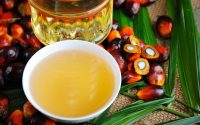What Is Crude Palm Oil?
Palm oil, an oil extracted from the palm nut kernel, is one of the few natural oils to have a high amount of saturated fat when compared to oils such as vegetable and olive oil, which are high in unsaturated fat. Before it is the clear oil available on grocery shelves, it is crude palm oil (CPO). This is the pre-purified oil that is extracted from the kernel. As with all crude oils, CPO has non-glyceride components such as trace metals, kernel shell pieces and products of oxidation. The purification process removes these components and makes the palm oil edible and sellable.
When a palm kernel is harvested, smashed and heated, it is not a clear oil that is first produced. What comes out of this initial process is crude palm oil, which is much thicker, lumpier and full of many inedible components. While some of those components are edible, they interfere with the oil’s color or taste, making the oil less valuable to buyers and sellers.
To remove the crude components, crude palm oil goes through a purification phase. Most oils go through such a phase to remove the unwanted components and to smooth out the oil. The first step of purification is removing the easily culled components, such as fruit pieces and fiber, shells and excess moisture. No chemical processes are needed to remove these components.
After this comes the removal of deeper components, a step that may require the use of chemicals. These components include naturally present trace metals, unsaturated steroid alcohols, products from oxidation and exposure to air, and phospholipids, or fats with a phosphorous molecule. The removal of these substances increases the crude palm oil’s value, making it a sellable and useable product.
A few components in the oil are not removed, because they help the oil’s flavor and shelf life. These components include tocopherols and tocotrienols, both alcohol products mostly composed of vitamin E. The removal of these components would actually damage the palm oil’s value.
While many countries produce crude palm oil, two countries account for the overwhelming majority of palm oil production. Malaysia and Indonesia create the most palm oil in the world. As of 2011, they account for 80 percent of all palm oil extraction. The purification is usually handled by other countries, or by CPO buyers, but some of the refining is done in Malaysia and Indonesia.


